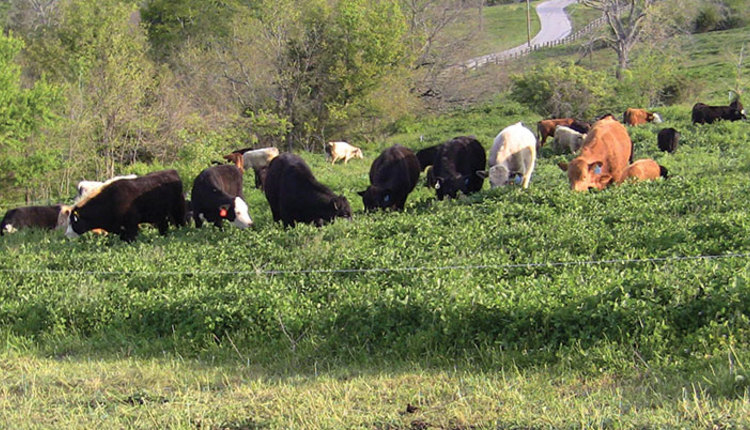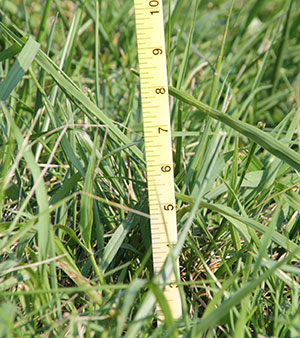
For centuries, beef cattle production has relied on forages and grazing. Typically, the land resources utilized to support ruminant production are nontillable acres. The productivity of this land is limited by fertility, organic matter, and/or topsoil depth. Forage production, therefore, is a major influence on livestock performance. Optimizing grazing productivity hinges on forage availability.
Soil maps are a valuable starting place to evaluate forage production potential of land resources. The Natural Resource Conservation Service (NRCS) provides information on soil types and productivity. This information is available through the Web Soil Survey portal.
Here in central Kentucky there are many acres that have shallow top soil and limestone outcroppings. These soil types dry out quickly and the limited soil moisture reduces forage production potential. When looking at farms to buy or lease, these soil maps can aid in determining the productivity of the farm, allowing one to negotiate prices.
Forage production potential will relate to the stocking rate. Stocking rate is the number of animals or the pounds of beef supported on a defined area for a given period of time. The stocking rate that is supported over the entire grazing season is referred to as the carrying capacity of the farm. Soils that support greater forage production will inherently support more livestock and higher stocking rates.
In central Kentucky, carrying capacity may be 2 to 4 acres per cow-calf pair. For growing cattle on a stocker operation, a stocking rate of 750 pounds per acre is typical. If we assume dry matter intakes near 2.5% of body weight, the forage needs for 250 days of grazing would be estimated at slightly more than 4,000 pounds.
Hit the stocking sweet spot
Not all forage produced is consumed, and if grazing efficiency is 50%, the total forage production needed is around 4 tons per animal. Estimated forage production in variety trials conducted in central Kentucky for tall fescue often ranges between 3 to 6 tons of dry matter per acre. This would mean that if growing cattle were on pasture from 500 to 800 pounds, an average stocking rate would be about one calf per acre.
Improving forage-based livestock production will be dependent on the stocking rate. Understocking, or too few animals, will allow for greater forage selectivity and better individual animal performance. Understocking, however, will often have less production per unit of land.
On the other hand, having too many animals and a high stocking rate will reduce selectivity and potentially suppress individual gain. Overgrazing may lead to suppressed production per unit of land due to insufficient forage availability. For grazing livestock producers, improving forage production allows for greater stocking rates and profit potential.
Forage availability is a key factor in animal performance and productivity. For mature grazing animals, nearly 70% to 80% of their daily intake goes toward maintenance of existing body tissue and body functions. Intake limitation can significantly impact lactation or body tissue accretion. Many factors contribute to the intake of grazing animals. Rumen fill can impact forage intake, with low rumen volumes signaling a desire to eat more.
Passage rate or the speed at which forage is digested into a particle size small enough to pass out of the rumen also affects intake. The more mature a forage, the slower the degradation and passage rate, which reduces intake. Grazing strategies that keep forages vegetative provide greater opportunity to optimize intake and animal productivity.
Standing forage availability has been shown to impact forage intake. Forage availability less than approximately 1,000 pounds of dry matter per acre is expected to reduce intakes. In many cool-season pastures, this is approximately 3 inches in height for dense swards. It is not uncommon to see pastures that are grazed shorter than 3 inches in mid-summer. Overstocking livestock will lead to limited forage availability, suppressed intakes, and reduced animal performance.
Fat off their back
The act of grazing has been shown to lead to greater energy expenditure, which can limit performance. I normally tell producers that during the first green flush of grass in the spring, they can watch lactating cows walk the fat off their backs. This is partially due to the fact that the fresh grass is more palatable than hay, and the cows will prefer this new growth. The limited forage availability results in greater physical activity as cows seek to fill their rumen.

Limited standing forage availability will only further compound issues with energy balance if intake isn’t maximized. Waiting for forage to get to a 3- to 4-inch height before spring turnout can improve bite size and reduce energy expended from grazing.
Pasture damage looms large
This season, much of Kentucky experienced an early fall drought. This limited forage production and led to overgrazing on many farms. The insufficient pasture growth not only caused reduced gains of growing animals and body condition loss of lactating cows, it likely also will reduce forage persistency and, in some cases, weaken or thin forage stands.
Often, steps are not taken early enough to reduce stocking rates or provide supplemental forage or grain to limit pasture damage. It is likely that we will see more weeds and overall reduced pasture productivity next spring. Encroachment of undesirable, unpalatable plants will reduce forage availability and potentially limit intake. For the Fescue Belt, frost seeding red clover in February is a cost-effective pasture improvement strategy.
In an effort to improve profitability of forage-based livestock production systems, livestock managers need to focus on forage production and grazing management. Learning more about the forage production potential of the farm can enhance one’s ability to appropriately stock grazing operations. Invest time before the next grazing season to prioritize actions that will enhance forage production and standing forage availability for grazing livestock. Happy grazing!
This article appeared in the February 2020 issue of Hay & Forage Grower on pages 18 and 19.
Not a subscriber? Click to get the print magazine.

